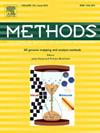通过T7 RNA聚合酶和CRISPR/ cas13a增强的电化学发光生物传感器超灵敏检测MMP-2在COPD诊断中的应用
IF 4.3
3区 生物学
Q1 BIOCHEMICAL RESEARCH METHODS
引用次数: 0
摘要
在这项工作中,开发了一种集成T7 RNA聚合酶扩增和CRISPR/ cas13a介导的信号增强的电化学发光(ECL)生物传感器,用于超灵敏检测基质金属蛋白酶-2 (MMP-2),这是与慢性炎症性疾病(如COPD)相关的关键生物标志物。设计了一种肽核酸(PNA)探针,专门响应MMP-2的切割,从而释放DNA模板,用于随后的T7 RNA聚合酶驱动的转录扩增。生成的RNA触发CRISPR/Cas13a的侧支裂解活性,导致ECL信号显著扩增。生物传感器表面采用AuNPs/Ti3C2Tx/Ru(II)-PEI纳米复合材料构建,增强了信号转导和稳定性。在优化条件下,所提出的生物传感器的检测限低至62.05 fM,与传统方法相比具有更高的灵敏度,如表1所示。该平台还具有出色的特异性和抗干扰能力,确保了复杂生物样品中MMP-2的可靠检测。本研究提供了一种简单而高效的酶促生物标志物检测策略,在疾病早期诊断和监测方面具有很大的临床应用潜力。本文章由计算机程序翻译,如有差异,请以英文原文为准。
Ultrasensitive detection of MMP-2 via T7 RNA polymerase and CRISPR/Cas13a-Enhanced electrochemiluminescence biosensor for COPD diagnosis
In this work, an electrochemiluminescence (ECL) biosensor integrating T7 RNA polymerase amplification and CRISPR/Cas13a-mediated signal enhancement was developed for the ultrasensitive detection of matrix metalloproteinase-2 (MMP-2), a key biomarker associated with chronic inflammatory diseases such as COPD. A peptide nucleic acid (PNA) probe was designed to respond specifically to MMP-2 cleavage, enabling the release of DNA templates for subsequent T7 RNA polymerase-driven transcription amplification. The generated RNA triggers the collateral cleavage activity of CRISPR/Cas13a, resulting in a significant amplification of the ECL signal. The biosensor’s surface was constructed using a AuNPs/Ti3C2Tx/Ru(II)-PEI nanocomposite, which enhanced signal transduction and stability. Under optimized conditions, the proposed biosensor achieved a detection limit as low as 62.05 fM, demonstrating superior sensitivity compared to conventional methods, as summarized in Table 1. The platform also exhibited excellent specificity and anti-interference capability, ensuring reliable detection of MMP-2 in complex biological samples. This study provides a simple yet highly efficient strategy for enzymatic biomarker detection, offering great potential for clinical applications in early disease diagnosis and monitoring.
求助全文
通过发布文献求助,成功后即可免费获取论文全文。
去求助
来源期刊

Methods
生物-生化研究方法
CiteScore
9.80
自引率
2.10%
发文量
222
审稿时长
11.3 weeks
期刊介绍:
Methods focuses on rapidly developing techniques in the experimental biological and medical sciences.
Each topical issue, organized by a guest editor who is an expert in the area covered, consists solely of invited quality articles by specialist authors, many of them reviews. Issues are devoted to specific technical approaches with emphasis on clear detailed descriptions of protocols that allow them to be reproduced easily. The background information provided enables researchers to understand the principles underlying the methods; other helpful sections include comparisons of alternative methods giving the advantages and disadvantages of particular methods, guidance on avoiding potential pitfalls, and suggestions for troubleshooting.
 求助内容:
求助内容: 应助结果提醒方式:
应助结果提醒方式:


